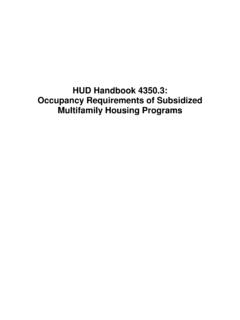Transcription of A WHITE PAPER - Community Frameworks
1 TINY HOUSES A Permanent Supportive Housing Model A WHITE PAPER Created by Community Frameworks March 2015 Quixote Village Cottage January 2014 Community Frameworks mission is to support and develop affordable housing as a foundation upon which individuals, families and neighborhoods can build vital communities. To accomplish this mission, we develop affordable multi-family and supportive housing, provide homeownership opportunities for hard working families, and teach and counsel families on budgeting, credit, and homeownership topics. We also work with other nonprofits, by providing technical assistance, financing, or by developing affordable housing for them.
2 Bremerton Office 409 Pacific Ave Suite 105 Bremerton WA 98337 Spokane Office 315 W. Mission Ave Suite 100 Spokane WA 99201 Visit Us Online This WHITE PAPER Provided by: Community Frameworks There has been significant recent publicity about tiny houses and tiny home communities for homeless households. This PAPER argues that tiny homes should be a model for subsidized permanent supportive housing and one of the tools in the tool box to respond to homelessness. In particular, tiny houses provide a promising model for permanent supportive housing for single homeless adults because: subsidized housing is expensive, and tiny houses could reduce the per unit cost by more than half, thereby stretching limited resources to house more people.
3 Small, individual units with shared kitchen and/or bathing facilities balance individual private space with shared Community space, thereby fostering positive Community engagement and encouraging residents to interact with peers, volunteers and staff. Many communities throughout the United States have implemented some version of the tiny house concept in response to homelessness. Most of these communities use non-permanent structures that are not heated nor insulated, do not have plumbing, and are not on permanent foundations. TINY HOUSES A Permanent Supportive Housing Model In December of 2013, Community Frameworks completed the development of Quixote Village in Olympia Washington.
4 To our knowledge, this is the only publically subsidized permanent supportive tiny house project in the country. Quixote Village is comprised of 30 tiny cottages with baths for homeless adults and a Community building with a large kitchen, bathing rooms and two multi-purpose common spaces on a 2 acre site. This publication uses Quixote Village as an example of the implementation of this unique model. CASE STUDY: QUIXOTE VILLAGE 1 DEFINING THE MODEL Tiny Houses for Homeless Adults Chronically Homeless Adults and Housing Options The US Department of Housing and Urban Development (HUD) defines a chronically homeless individual as a person who has been homeless for a year or longer, or who has experienced at least four episodes of homelessness in the last three years, and has a disability.
5 Many chronically homeless individuals struggle with mental illness and/or substance abuse challenges and many have physical disabilities. Generally the population consists of people who are medically vulnerable and high users of emergency services. In the past many people in this demographic were housed in single room occupancy apartments, essentially bedrooms with shared kitchens and bathrooms, or rooming houses. As these forms of housing have largely disappeared from American cities and towns, this group, which has limited earning potential and high rates of disabilities, has few housing options, and virtually none that are unsubsidized.
6 According to Why are People Homeless, a PAPER published by the National Coalition for the Homeless in June, 2007: A housing trend with a particularly severe impact on homelessness is the loss of single room occupancy (SRO) housing. In the past, SRO housing served to house many poor individuals, including poor persons suffering from mental illness or substance abuse. From 1970 to the mid-1980s, an estimated one million SRO units were demolished (Dolbeare, 1996). The demolition of SRO housing was most notable in large cities: between 1970-1982, New York City lost 87% of its $200 per month or less SRO stock; Chicago experienced the total elimination of cubicle hotels; and by 1985, Los Angeles had lost more than half of its downtown SRO housing (Koegel, et al, 1996).
7 From 1975 to 1988, San Francisco lost 43% of its stock of low-cost residential hotels; from 1970 to 1986, Portland, Oregon lost 59% of its residential hotels; and from 1971 to 1981 Denver lost 64% of its SRO hotels (Wright and Rubin, 1997). Thus the destruction of SRO housing is a major factor in the growth of homelessness in many cities. 2 Most of the residents of Quixote Village meet HUD s definition of chronic homelessness. The 30 cottages at Quixote Village are 144 square feet which includes a 1/2 bath and closet. Each cottage has a front porch and garden area. The Community building has a large kitchen with two sets of appliances and four refrigerators; locking cold and dry storage for each resident; four bathing rooms with tubs or showers; restrooms; a large dining/living area with a wood stove; a conference room for classes, meetings or recreational use; a laundry room; and two offices.
8 In addition there is a large Community vegetable garden. The original plan for Quixote Village did not include toilets and sinks in the cottages, only shared restrooms in common buildings. Funders, Community members, and experienced providers encouraged Panza, the sponsor of Quixote Village, to re-think this, arguing that it would be difficult for people to stay permanently without baths and it was unfair to residents who would have to dress and venture out, rain or shine, night or day, in sickness or in health, to go to the bathroom. Plumbing each cottage required extending water and sewer lines through out the site and did result in a higher capital cost.
9 The money was well spent; the baths improve the quality of life for the residents. CASE STUDY: QUIXOTE VILLAGE Although the phenomenon of losing single room occupancy housing is not as well documented for smaller communities, it is likely that this trend has contributed to homelessness throughout America as building and zoning codes have fewer allowances for very small housing units and shared kitchens and bathing rooms. Struggling to respond to modern homelessness since the late 1980 s, communities around the country have explored different housing and shelter strategies.
10 Transitional housing, using an up and out of poverty model was popular, offering supports for people to overcome personal challenges and increase their earning potential. However, this approach was unsuccessful for some who cycled through shelters, transitional housing, and back onto the streets. The current nationally accepted best practice is permanent supportive housing (PSH). This model provides non time-limited housing with voluntary supportive services tailored to individual needs. Some residents use this housing as a stepping stone to other housing options. Others remain, needing Community support and services to succeed over time.




